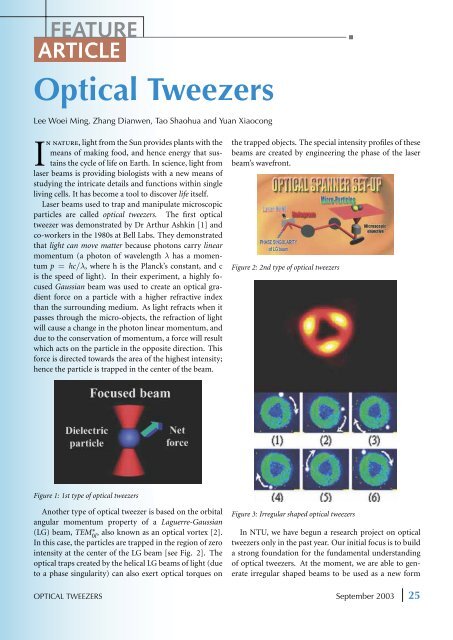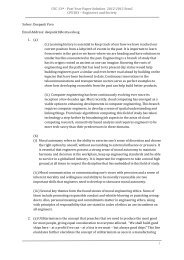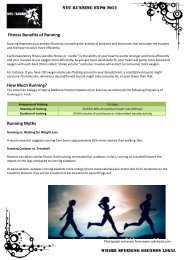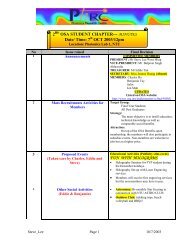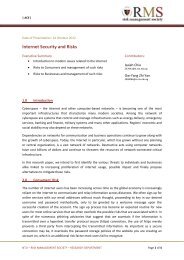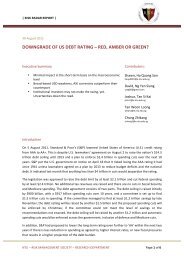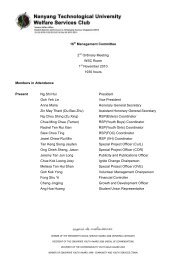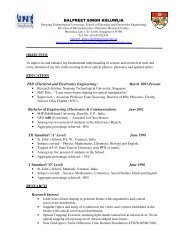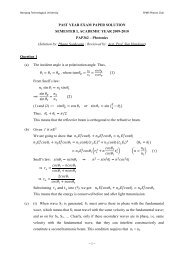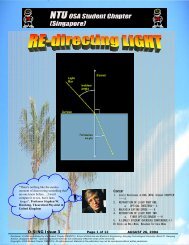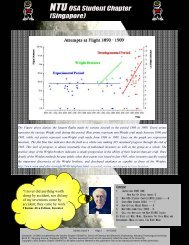PhRC NEWSLETTER PHOTONICS'La - Nanyang Technological ...
PhRC NEWSLETTER PHOTONICS'La - Nanyang Technological ...
PhRC NEWSLETTER PHOTONICS'La - Nanyang Technological ...
Create successful ePaper yourself
Turn your PDF publications into a flip-book with our unique Google optimized e-Paper software.
FEATURE<br />
ARTICLE<br />
Optical Tweezers<br />
Lee Woei Ming, Zhang Dianwen, Tao Shaohua and Yuan Xiaocong<br />
In nature, light from the Sun provides plants with the<br />
means of making food, and hence energy that sustains<br />
the cycle of life on Earth. In science, light from<br />
laser beams is providing biologists with a new means of<br />
studying the intricate details and functions within single<br />
living cells. It has become a tool to discover life itself.<br />
Laser beams used to trap and manipulate microscopic<br />
particles are called optical tweezers. The first optical<br />
tweezer was demonstrated by Dr Arthur Ashkin [1] and<br />
co-workers in the 1980s at Bell Labs. They demonstrated<br />
that light can move matter because photons carry linear<br />
momentum (a photon of wavelength λ has a momentum<br />
p = hc/λ, where h is the Planck’s constant, and c<br />
is the speed of light). In their experiment, a highly focused<br />
Gaussian beam was used to create an optical gradient<br />
force on a particle with a higher refractive index<br />
than the surrounding medium. As light refracts when it<br />
passes through the micro-objects, the refraction of light<br />
will cause a change in the photon linear momentum, and<br />
due to the conservation of momentum, a force will result<br />
which acts on the particle in the opposite direction. This<br />
force is directed towards the area of the highest intensity;<br />
hence the particle is trapped in the center of the beam.<br />
Figure 1: 1st type of optical tweezers<br />
Another type of optical tweezer is based on the orbital<br />
angular momentum property of a Laguerre-Gaussian<br />
(LG) beam, TEM∗ 0l , also known as an optical vortex [2].<br />
In this case, the particles are trapped in the region of zero<br />
intensity at the center of the LG beam [see Fig. 2]. The<br />
optical traps created by the helical LG beams of light (due<br />
to a phase singularity) can also exert optical torques on<br />
the trapped objects. The special intensity profiles of these<br />
beams are created by engineering the phase of the laser<br />
beam’s wavefront.<br />
Figure 2: 2nd type of optical tweezers<br />
Figure 3: Irregular shaped optical tweezers<br />
In NTU, we have begun a research project on optical<br />
tweezers only in the past year. Our initial focus is to build<br />
a strong foundation for the fundamental understanding<br />
of optical tweezers. At the moment, we are able to generate<br />
irregular shaped beams to be used as a new form<br />
OPTICAL TWEEZERS September 2003 25


